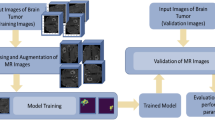Abstract
The early automatic detection of brain tumors in MRI scans is a challenging endeavor due to the high resolution of the images. For a very long time, continual research efforts have been floating a new notion of substituting various grayscale anatomic parts of diagnostic pictures with suitable colors. If successful, this would be an effective way for radiologists to circumvent the challenges they now encounter. The coloring of grayscale photos is a complex process that aims to improve the contrast of different sections of an image by changing grayscale images into color pictures with high levels of contrast. It is common for the predictions to be lacking in fine detail when simply a U-Net design is used; to assist alleviate this issue, cross or skip connections may be introduced between the blocks of the network. Instead of creating a skip connection every two convolutions as it now is in a ResBlock, the skip connections cross from a portion of the same size in the downsampling route to a part in the upsampling path. This improves the overall accuracy of the model and performs better when compared to traditional UNet model.








Similar content being viewed by others
Data Availability
Enquiries about data availability should be directed to the authors.
References
Amin J, Sharif M, Yasmin M, Fernandes SL (2020) A distinctive approach in brain tumor detection and classification using MRI. Pattern Recogn Lett 139:118–127
Amin J, Muhammad Sharif, AH, Mussarat Y, Ramesh Sundar N (2021) Brain tumor detection and classification using machine learning: a comprehensive survey. Complex & Intelligent Systems pp 1–23.
Banerjee S, Sushmita M, Francesco M, Stefano R (2018) Brain tumor detection and classification from multi-sequence MRI: study using ConvNets. In: International MICCAI brainlesion workshop, pp. 170–179. Springer, Cham
Clark K, Vendt B, Smith K et al (2013) The cancer imaging archive (TCIA): maintaining and operating a public information repository. J Digit Imaging 26(6):1045–1057
Das V (2016) Techniques for MRI brain tumor detection: a survey. Int J Res Comput Appl Inform Technol 4(3):53–56
Gupta RK, Santosh Bharti, NK, Yatendra S, Nikhlesh P (2022) Brain tumor detection and classification using cycle generative adversarial networks." Interdisciplin Sci: Comput Life Sci pp. 1–18.
Isensee F, Paul FJ, Peter MF, Philipp V, Klaus HM-H (2021) nnU-Net for brain tumor segmentation. In: International MICCAI Brainlesion Workshop, pp. 118–132. Springer, Cham
Işın A, Direkoğlu C, Şah M (2016) Review of MRI-based brain tumor image segmentation using deep learning methods. Procedia Comput Sci 102:317–324
Kaur G (2016) MRI brain tumor segmentation methods-a review. Int J Current Eng Technol 6(3):760–764
Khairandish MO, Sharma M, Jain V, Chatterjee JM, Jhanjhi NZ (2021) A hybrid CNN-SVM threshold segmentation approach for tumor detection and classification of MRI brain images." IRBM.
Khambhata K (2016) Multiclass classification of brain tumor in MR images. Int J Innovat Res Comput Commun Eng 4(5):8982–8992
Lin W-C, Tsao EC-K, Chen C-T (1991) Constraint satisfaction neural networks for image segmentation. Artificial Neural Netw 25(7):1087–1090
Mohan G, Subashini MM (2018) MRI based medical image analysis: survey on brain tumor grade classification. Biomed Signal Process Control 39:139–161
Myronenko A (2018) 3D MRI brain tumor segmentation using autoencoder regularization. In: International MICCAI Brainlesion Workshop, pp. 311–320. Springer, Cham, 2018.
Nazir M, Shakil S, Khurshid K (2021) Role of deep learning in brain tumor detection and classification (2015 to 2020): a review. Comput Med Imaging Graph 91:101940
Singh N, Ahuja NJ (2019) Bug model based intelligent recommender system with exclusive curriculum sequencing for learner-centric tutoring. Int J Web-Based Learn Teach Technol 14(4):1–25
Tiwari A, Srivastava S, Pant M (2020) Brain tumor segmentation and classification from magnetic resonance images: Review of selected methods from, 2014 to 2019. Pattern Recogn Lett 131(2020):244–260
Wang, Wenxuan, Chen Chen, Meng Ding, Hong Yu, Sen Zha, and Jiangyun Li. "Transbts: Multimodal brain tumor segmentation using transformer." In International Conference on Medical Image Computing and Computer-Assisted Intervention, pp. 109–119. Springer, Cham, 2021.
Zeineldin RA, Karar ME, Coburger J, Wirtz CR, Burgert O (2020) DeepSeg: deep neural network framework for automatic brain tumor segmentation using magnetic resonance FLAIR images. Int J Comput Assist Radiol Surg 15(6):909–920
Zhao, Y-X, Yan-Ming Z, Cheng-Lin L (2020) Bag of tricks for 3D MRI brain tumor segmentation. In: International MICCAI Brainlesion Workshop, pp. 210–220. Springer, Cham
Funding
This research did not receive any funding.
Author information
Authors and Affiliations
Corresponding author
Ethics declarations
Conflict of interest
There are no potential conflicts of interest.
Ethical approval
Ethical approval is not required.
Availability of data and materials
Dataset link: https://www.kaggle.com/datasets/mateuszbuda/lgg-mri-segmentation.
Additional information
Publisher's Note
Springer Nature remains neutral with regard to jurisdictional claims in published maps and institutional affiliations.
Rights and permissions
Springer Nature or its licensor (e.g. a society or other partner) holds exclusive rights to this article under a publishing agreement with the author(s) or other rightsholder(s); author self-archiving of the accepted manuscript version of this article is solely governed by the terms of such publishing agreement and applicable law.
About this article
Cite this article
Bindu, N.P., Sastry, P.N. Automated brain tumor detection and segmentation using modified UNet and ResNet model. Soft Comput 27, 9179–9189 (2023). https://doi.org/10.1007/s00500-023-08420-5
Accepted:
Published:
Issue Date:
DOI: https://doi.org/10.1007/s00500-023-08420-5




